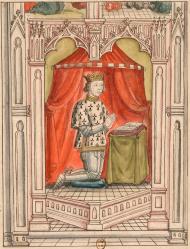Qui est sorti avec Antoinette De Maignelais?
François II de Bretagne a daté Antoinette De Maignelais du ? au ?.
Charles VII of France a daté Antoinette De Maignelais du ? au ?.
Antoinette De Maignelais
François II de Bretagne

François II de Bretagne, en breton : Frañsez II, né le à Clisson et mort le à Couëron, est duc de Bretagne de 1458 à 1488.
Seul fils survivant de Richard d'Étampes, lui-même fils du duc de Bretagne Jean IV, il devient à la mort de son père comte titulaire d'Étampes, puis est désigné par le duc Pierre II de Bretagne (1418–1457) comme second héritier présomptif du duché de Bretagne après Arthur III de Bretagne, devenant effectivement duc en 1458.
Par sa mère Marguerite d'Orléans (1406-1466), fille du duc d'Orléans Louis Ier (1372–1407), il est lié à l'aristocratie française des princes du sang : il est notamment le neveu du duc et poète Charles Ier (1394–1465) et le cousin du duc Louis II (1462–1515), futur roi de France Louis XII.
Son règne est marqué par une longue lutte contre les rois de France Louis XI, puis Charles VIII, en liaison avec certains princes féodaux de France, dont Louis II d'Orléans, durant la Guerre folle, qui aboutit en 1488 à la défaite de Saint-Aubin-du-Cormier, et à l'arrivée sur le trône de Bretagne de la jeune duchesse Anne de Bretagne, mariée en 1491 à Charles VIII.
Il est également titré comte de Montfort, de Vertus, et de Richemont.
Lire la suite...Antoinette De Maignelais
Charles VII of France

Charles VII (22 February 1403 – 22 July 1461), called the Victorious (French: le Victorieux) or the Well-Served (le Bien-Servi), was King of France from 1422 to his death in 1461. His reign saw the end of the Hundred Years' War and a de facto end of the English claims to the French throne.
During the Hundred Years' War, Charles VII inherited the throne of France under desperate circumstances. Forces of the Kingdom of England and the duke of Burgundy occupied Guyenne and northern France, including Paris, the capital and most populous city, and Reims, the city in which French kings were traditionally crowned. In addition, his father, Charles VI, had disinherited him in 1420 and recognized Henry V of England and his heirs as the legitimate successors to the French crown. At the same time, a civil war raged in France between the Armagnacs (supporters of the House of Valois) and the Burgundian party (supporters of the House of Valois-Burgundy, which was allied to the English).
With his court removed to Bourges, south of the Loire river, Charles was disparagingly called the "King of Bourges", because the area around this city was one of the few remaining regions left to him. However, his political and military position improved dramatically with the emergence of Joan of Arc as a spiritual leader in France. Joan and Jean de Dunois led French troops to lift the siege of Orléans and other besieged strategic cities on the Loire river, and to defeat the English at the Battle of Patay. With local English troops dispersed, the people of Reims switched allegiance and opened their gates, which enabled Charles VII to be crowned at Reims Cathedral in 1429. Six years later, he ended the Anglo-Burgundian alliance by signing the Treaty of Arras with Burgundy, followed by the recovery of Paris in 1436 and the steady reconquest of Normandy in the 1440s using a newly organized professional army and advanced siege cannons. Following the Battle of Castillon in 1453, the French recaptured all of England's continental possessions except the Pale of Calais.
The last years of Charles VII were marked by conflicts with his turbulent son, the future Louis XI.
Lire la suite...